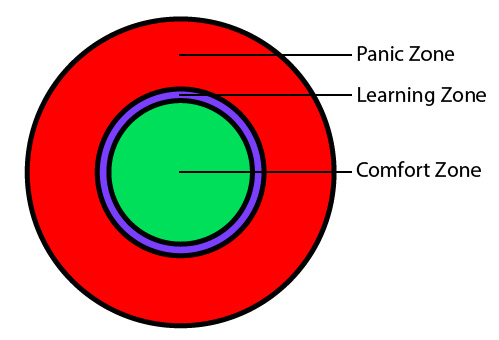We’ve all heard of the comfort zone, but did you know there’s 2 other zones?

Knowing the 3 zones can help your productivity and ensure that you avoid staying stagnant by being in the learning zone.
1. The Comfort Zone
The comfort zone is where many of us operate. It’s the location of the skills and abilities we’ve acquired. While the comfort zone is by definition the most ‘comfortable’, we can’t make progress or build skills in the comfort zone since it consists of the abilities we can already do easily.
2. The Panic Zone
If you’ve ever become so anxious you can no longer think, you’ve probably run into the panic zone. Activities in the panic zone are so tough that we don’t even know how to approach them. The overall feeling of the panic zone is that you are uncomfortable and possibly discouraged. Like the comfort zone, we can’t make progress in the panic zone. You may be in the panic zone when attempting something dangerous, far beyond your reach or under high stress.
3. The Learning Zone
Between the panic zone and the comfort zone is the learning zone. One can only make progress by choosing activities in the learning zone. The skills and abilities that are just out of reach are in the learning zone; they’re neither so far away that we panic nor close enough where they’re too easy.
Identifying the Learning Zone
Since we can only make progress by choosing activities in the learning zone, it’s important to be able to find our learning zone.

Image: graur razvan ionut
Both the comfort zone and panic zone can be confused for the learning zone. I used to give saxophone lessons, and my students would wonder why they never were getting better. It turned out they were practicing in their comfort zone. They were taking the things they already knew (like a piece of music) and playing it over and over. While “practicing” they were essentially going over the motions, but not engaged and therefore they weren’t getting better. If the task at hand is boring or too easy, it’s an indication that we’re not in the learning zone.
On the opposite end, we can also mistake the panic zone as the learning zone. Some people make this mistake since they’ve heard “no pain no gain” so many times. However, they’re not synonymous and if this were true, the happiest and most successful people would be in lots of pain. If you’ve ever watched someone learn to swim, they often start in the panic zone and need to be talked down into the learning zone before they can actually acquire the skills to stay above water. While the panic zone and learning zone may involve forms of “pain” and challenges, the panic zone is a place where we are lost and in the learning zone we are focused and open to new ideas.
So, if we know that boredom is an indication of the comfort zone, and losing focus or being frantic is indicative of the panic zone, the learning zone is easier to spot. The learning zone can also be thought of as the growth, engaged, or enjoyment zone. When we learn, there’s usually a level of engagement or enjoyment. We’re neither bored nor uneasy; we’re learning. Identifying what zone you are in and making the necessary adjustments to be in the learning zone will mean consistent progress and growth.
Staying in the Learning Zone
The three zones are constantly changing and forcing oneself to stay in the learning zone is a hard task. As you operate in the learning zone, you will get more comfortable with the current skills and they’ll start to move into the comfort zone. As this happens, tasks that were once a part of the panic zone will move into the learning zone and the cycle will continue.
As an example, occasionally I get projects that are beyond my learning zone. This puts me in the panic zone of trying to figure out how to approach them. Taking a step back into the learning zone, i’ll research, read or talk to an expert. Eventually this leads to taking on new skills, thus transitioning the project from the panic zone to the learning zone and after deliberate practice into the comfort zone.
Being aware of these changes will help you stick to the learning zone through the transitions. The three zones can apply to everything, even physical activities. In bodybuilding, doing the same routine leads to a plateau (comfort zone) and it’s not until a new challenge is sought (learning zone) do the muscles have a chance to grow further.
Keep this in mind when participating in work or play and let me know if you notice a difference in the amount of growth that’s achieved.